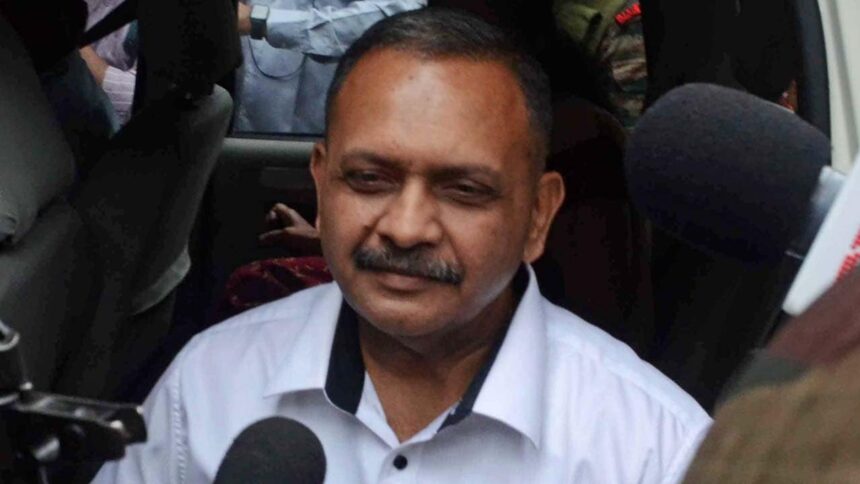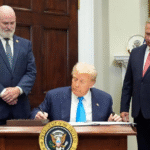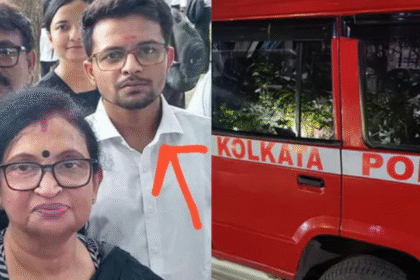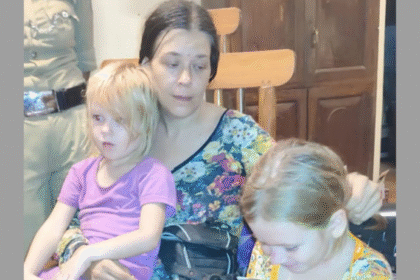Malegaon Case Exposes Hindutva Terrorist Network: Aseemanand & Purohit Named
Last week, the verdict of the Malegaon terror blast case exonerated the accused of the explosion which killed six people in front of a mosque in the town in September 2008.
The judges have made clear that there is not enough to prove that this blast was part of a conspiracy. This interpretation contradicts the 2011 confession of Swami Aseemanand and the report that had been prepared by Hemant Karkare, the chief of the Mumbai Anti-Terrorism Squad who was killed in the Mumbai attacks of November 2008.
This document is particularly interesting for two reasons. First, it provides rich pieces of factual information regarding the actors of the Malegaon plot who belonged to Abhinav Bharat. Second, it presents us with the discourse of the Hindu nationalists when they speak between themselves in camera since the report includes the transcripts of meetings they held in 2007-2008 and that one of the participants recorded. The most relevant excerpts are available at the end of the article.
Abhinav Bharat and the Malegaon plot
Abhinav Bharat was named after the movement V.D. Savarkar started in 1905 in Poona.
Himani Savarkar, 61, the daughter of Gopal Godse (the brother of Nathuram Godse, who killed Mahatma Gandhi in 1948) and the wife of Savarkar’s nephew, claimed that Abhinav Bharat had been started by Sameer Kulkarni, who asked her to be the chairman of the organisation. At that time, Himani Savarkar was the president of the Hindu Mahasabha, a party V.D. Savarkar directed from 1937 to 1942.
She told the police that she was elected president of Abhinav Bharat in April 2008 during a meeting in Bhopal. This meeting was attended by Swami Amritananda Dev Tirtha (a man also known under the names of Sudhakar Dwivedi, Sudhakar Dhar, and Dayanand Pandey and whom she calls the “Jammu and Kashmir Shankaracharya”), Sadhvi Pragya Singh Thakur, Major Ramesh Upadhyay, Sudhakar Chaturvedi and Lieutenant Colonel Prasad Purohit whom, she said, she had known for two years – their families being related for a long time.
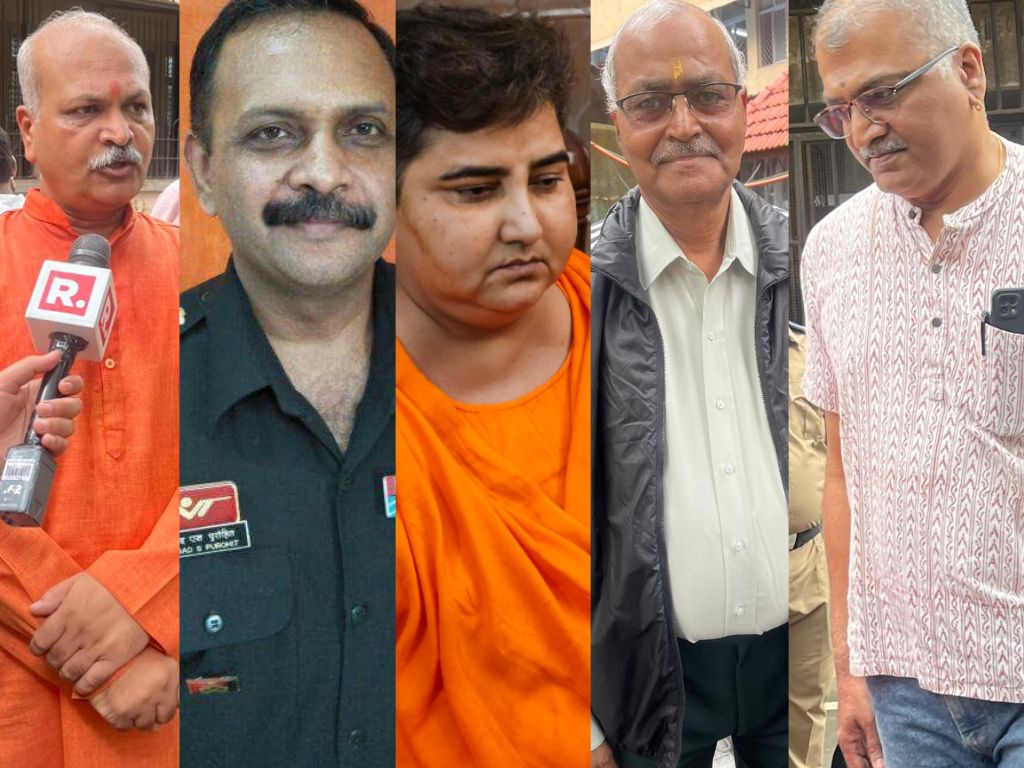
According to confessions made by other accused in the Malegaon case, Abhinav Bharat was founded by Purohit himself in June 2006. A significant meeting took place in June 2007 in Nasik district at the Deolali camp, where Amritananda Dev Tirtha was meeting his disciples. During this gathering, one of the interrogated participants claimed that Purohit strongly advocated for attacking Muslims using bomb blasts — an idea that was met with objection by others present.
Another meeting was held in Deolali in September 2007, once again involving the Mumbai group and Purohit. A notable addition to this meeting was B.L. Sharma, a former Bharatiya Janata Party (BJP) MP from East Delhi. Sharma had first met Amritananda Dev Tirtha in 2004 while visiting his constituency, where he enjoyed popularity among the Pandit refugees who had fled Kashmir.
According to the police, the plot related to the Malegaon blast was finalized through a series of four meetings held in 2008. One such meeting took place between January 25 and 27 near Faridabad, where Purohit, Upadhyay, Kulkarni, Chaturvedi, and Amritananda Dev Tirtha gathered at a building belonging to the Save Our Soul organisation, where Amritananda was staying.
The next key meeting occurred on April 11–12, 2008, in Bhopal, where the same group met with Pragya Singh Thakur. It was during this gathering that they allegedly conspired to take revenge against Muslims in Malegaon by planning a bomb explosion in a densely populated area. As per the police, Purohit agreed to supply the explosives, while Pragya Singh Thakur took on the responsibility of arranging manpower for carrying out the attack. All participants reportedly gave their consent to execute the Malegaon explosion.
On June 11, 2008, Pragya Singh Thakur introduced Ramchandra Kalasangra and Sandip Dange to Amritananda Dev Tirtha as two reliable persons who would plant the bomb in Malegaon. In early July, she asked Amritananda Dev Tirtha to direct Purohit “to give explosives” to Kalasangra and Dange in Pune.
On August 3, 2008, in a meeting held at the Dharmsala of Mahakaleshwar temple in Ujjain, Purohit was given the responsibility to procure RDX for Kalasangra and Dange. Purohit then asked Rakesh Dhawade, “a trained expert in committing explosions and assembling improvised explosive devices”, to provide explosives to Kalasangra and Dange at Pune, where they met on August 9 and 10.
Saffron clad activists, (ex-)Army men and Sangh Parivar cadres
The 11 accused of Abhinav Bharat who were involved in the Malegaon case come from three different milieus. They were either religious figures, (ex) Army men or Sangh Parivar cadres.
Amritananda Dev Tirtha claims to be the Shankaracharya of Sri Sharada Sarvagyapeeth, which is situated in Pakistan-occupied Kashmir (PoK). After his initial stay at Kanpur, Sudhakar Dhar shifted to Varanasi from where he reached Jammu in 2005-06 to float the Sarvagyapeeth.
Abhinav Bharat is the first such organisation in which at least two (ex) Army men have been deeply involved. Major Ramesh Upadhyay, a former defence services officer, was arrested first, and he immediately admitted that he had taken part in three meetings with Pragya Singh and her accomplices on the Nasik BMS premises to plan the Malegaon blast.
But the key figure of the group, as mentioned above, was Lt-Col. Prasad Purohit, who had approached Upadhyay when he was posted at Nasik as liaison officer. Purohit and Upadhyay imparted military training to young activists and were instrumental in procuring arms and explosives. Purohit forged documents during his stint in Jammu and Kashmir – where he was posted in 2004-05 – to obtain arms licence for others. After shifting to Panchmarhi (Madhya Pradesh) in July-August 2008, he organised training camps in which dozens of people took part and were taught to handle arms and explosives.
Even though there are only two (ex) Army men among the accused in the Malegaon case, the number of officers involved with Abhinav Bharat seems to have been more. At the meeting that took place in Faridabad in January 2008, one Colonel Aditya Dhar took part in the discussion, though very discreetly. Purohit also mentions a certain Major Parag Modak as “in charge of our international office.”
The case of Purohit is especially interesting because he mixed freely with Hindu nationalist leaders. Himani Savarkar, for instance, suggests that they met frequently and openly and that he made no secret of his admiration for Savarkar, including his craze for a more martial brand of Hinduism: “I am a member of the Maharashtra Military Foundation trust founded by Colonel Chitale and since Prasad Purohit always went to them he also came to visit me. Besides, he worships Savarkar and he was always borrowing and returning books by and on Savarkar.”
A third category of actors is made of members of the Sangh Parivar, including Pragya Singh Thakur, a “sadhvi”, who was an Akhil Bharatiya Vidyarthi Parishad (ABVP) leader in Ujjain and Indore until 1997, before becoming a member of the National Executive of the ABVP and taking up sannyas, a purported life of asceticism. In 2019, she was nominated by the BJP to contest a Lok Sabha seat in Bhopal and won against Congress’s Digvijaya Singh.
Sameer Kulkarni, who had created the Madhya Pradesh branch of Abhinav Bharat, was an RSS worker. During interrogation by the police on December 26, 2008, Himani Savarkar said: “I met Kulkarni some one and a half years ago when he was working as a full-time member of the RSS. Since my house is next to Savarkar’s, he would come often and I came to know him very well. Then he told me he would be in Madhya Pradesh to work for Abhinav Bharat.”
The best example of the Sangh Parivar workers who had been attracted by Abhinav Bharat, however, is B.L. Sharma. An RSS worker since 1940, Sharma was seconded to the BJP by the Sangh during the Ram Janmabhoomi movement, in which he was taking an active part on the VHP side. He won the Lok Sabha seat of East Delhi in 1991 and 1996, but resigned his seat and membership of the BJP in 1997. He then concentrated on VHP work as state secretary of the organisation.
Abhinav Bharat’s strategies
The strategy of Abhinav Bharat was to replace the Sangh Parivar in the area where, according to its leaders, it had failed — the domain of immediate action. While they did not question the Sangh Parivar’s ideology or agenda, they disagreed with its methods. This led to a form of rapprochement with certain Sangh leaders who shared their activist mindset. Purohit, for instance, had been in contact with Praveen Togadia and proposed that Abhinav Bharat could carry out bomb attacks while the Sangh Parivar would claim responsibility.
During the Faridabad meeting, Purohit revealed: “I asked Praveenbhai that I would make the action happen but, ‘Will you come forward to claim it? Will BJP come forward?’ He told me clearly that neither would come forward.” Expressing his disillusionment, Purohit added, “They have come into power but don’t know what to do.”
In parallel, Abhinav Bharat was determined to change the constitution of India. At the Faridabad meeting, Purohit opened the discussion by saying, “We will fight the Constitution to fight for our nation.” He also said: “We have to establish this country in accordance with the Vedic procedures, we want the Sanatan Dharma, the Vedic Dharma.”
The constitution, according to him, should provide for “one-party rule”: “Any Hindu on earth will be an honorary member of this organisation.” The organisation was supposed to be militarised since “every member at all levels will have the basic knowledge of weapons”. “An academy of indoctrination will be established. At the end of the course members will be tested and those who pass will be finally admitted”. The concluding comment that was made in the draft of the constitution that was discussed in Faridabad was: “Very important point: political excommunication of people whose ideas are detrimental to Hindu Rashtra…some of them should be killed.”
But what Purohit wanted to do first was to terrorise Muslims in order to unite them, because he saw polarisation as a precondition for a battle to the finish – that Hindus were bound to win. He said at the Faridabad meeting: “The day Muslims get united that will be our biggest victory. […] The plan is to begin striking at them and let the Imam Bukhari stand up for the community. He has to say that I will not tolerate injustices in Maharashtra; let them unite, start shouting together…we are working for unification of Islam, Christians and Maoists against us.”
For this he wanted Abhinav Bharat to become a “Phantom organisation – like a ghost that appeared from nowhere” which would gain what he called “nuisance value”, blast after blast by striking Muslims without claiming responsibility for any of these attacks. Eventually, this “nuisance value” was supposed to give it some bargaining power, so much so the organisation could join the political process – by taking over the VHP and transforming itself into a political party.
Abhinav Bharat was responsible for three bomb blasts. Before Malegaon, it was responsible for two others. During the Faridabad meeting, Purohit disclosed this secret: “I will say something, which hasn’t been said before: we did two operations. They were both successful. I am capable of doing operations. I have no shortage of equipment. I can produce equipments (sic). I can get the equipments if and once I make up my mind. But to select the target, in my opinion, should not be my prerogative alone. We will decide this in the council or not?”
During a private conversation with Swami Amritanand on January 25, 2008, Major Upadhyay revealed details about one of the two planned operations. He suggested that some members of Abhinav Bharat should be deployed to spread fear among Muslim and Christian communities. Referring to the Hyderabad mosque blast, he claimed it was not carried out by ISI agents but by someone from their own group. “I can say this on basis of my knowledge. This was done in the name of duty,” he stated.
The second attack Upadhyay alluded to could possibly be the Nanded blast or the bombings in Parbhani or Jalna. These incidents are significant as Rakesh Dhawade, one of the accused in the Malegaon case, had already been implicated in those earlier attacks.
For these operations, Purohit raised money and trained quite a few people. The Malegaon FIR reads: “Accused Prasad Purohit collected huge amount of funds to the tune of Rs. 21,00,000 for himself and for his Abhinav Bharat organisation to promote his fundamentalist organization”.
The Israeli and Nepali connections
The Abhinav Bharat leaders found supporters in Israel and Nepal. Purohit said, in the Faridabad meeting:
“I made contacts in Israel – one of our ‘captains’ has already gone and returned from there. We received a very positive response. They told us, ‘you should show us something on the ground.’ We made four demands: (i) continuous and uninterrupted supply of equipment and training, (ii) permission to start an office with a saffron flag in Tel Aviv, (iii) political asylum, and (iv) support for our cause at the UN for the formation of a Hindu nation.”
“They agreed to two of these. They declined the request for a saffron flag office in Tel Aviv, citing improving diplomatic ties with India, and refused international support for two years until our movement shows momentum. However, they offered political asylum anytime, and equipment and training once we act. Even if I met these goals, I felt I shouldn’t act alone. We need to form a council and assess our needs. Also, our meeting with King Gyanendra was fixed for June 25, both in 2006 and 2007, arranged telephonically on February 13.”
“There is one Col. Prajwal. He has been appointed as a Brigadier in Intelligence. We had tried hard to fix this meeting. I proposed him, which he accepted that my 20 men will receive training as officers. Every six months to a year I will have 40 men and my 200 men will receive training as soldiers. So in one year I will have 400 men. You [Nepal] being an independent nation should ask for AKS from Czechoslovakia. We will pay the money and the ammunition. That is not a worry. The King accepted this.”
The Abhinav Bharat leaders were in touch with Nepali royalist groups which had just been declared terrorist groups. R.P. Singh stated in the Faridabad meeting:
“In today’s date, the Lok Tantric Madhesi Morcha and the Jana Tantric Madhesi Morcha have been declared terrorist organizations. Some of their leaders are currently based in Uttar Pradesh and Bihar, and we remain in continuous contact with them. Jwalasingh’s group supports a symbolic monarchy, which aligns with our vision. We believe this is a democratic and symbolic era, and only through such a monarchy can Hindutva survive. A full monarchy is no longer viable in today’s world, which is why we are actively supporting a symbolic version.”
“This movement has strengthened our influence in and around Kathmandu. As a symbolic gesture of our growing power, we carried out a small blast intended to instill fear but not cause harm. We had an understanding with a prominent political party, whose leader was recently arrested by Maoists. We are currently working for his release. A key development following this is our plan to open a new office in New Delhi, where we will begin organizing and enlisting Nepalis into our ranks.”
The Malegaon case-related documents show that in the 2000s Hindu nationalists were prepared to resort to terrorism to fight Muslims and to introduce some regime change in India. Our analysis of these documents suggests that Abhinav Bharat had inherited the legacy of the Savarkarites who had always distinguished themselves from the RSS, whose methods were traditionally different as they wanted to convert society in a long-term perspective.
However, Sangh Parivar cadres have also been tempted by terrorism, as evident from the presence of some of them among the Abhinav Bharat leaders and from the confession of Swami Aseemanand, a man who belonged to both Abhinav Bharat and the VHP. This confession has been made under Clause 164 of the Criminal Procedure Clause before a magistrate and is, therefore, considered a legally admissible evidence.
The confession of Swami Aseemanand was particularly significant as it clearly indicated that several major bomb blasts—including Malegaon (2006, 2008), the Samjhauta Express (2007), Hyderabad’s Mecca Masjid (2007), Ajmer Dargah Sharif (2007), and Modasa (2008)—which collectively caused the deaths of 121 people, were orchestrated by individuals aligned with the ideology of Savarkar and groups like Abhinav Bharat. It also implicated Sunil Joshi, a pracharak from Dewas, and Sandeep Dange, an RSS figure from Shapur district near Indore.
More crucially, Aseemanand’s confession pointed to Indresh Kumar, a senior RSS leader, whose name appears in the chargesheet related to the Ajmer Dargah Sharif blast. Despite these serious allegations and the scale of the attacks, none of the accused high-profile leaders have been convicted, raising serious concerns about equality before the law in India and suggesting that some individuals may enjoy impunity.
This op-ed draws from a longer and copiously footnoted 2010 article on the Economic and Political Weekly that the readers may consult for a more detailed analysis: ‘Abhinav Bharat, the Malegaon blast and Hindu nationalism: Resisting and Emulating Islamist Terrorism.’
All the documents below come from the ‘List of FIR, Panchanama and CA Reports in (Malegaon Bomb Blast Case) ATS PS CR No 18/2008’ which had been drafted by Hemant Karkare. The selected excerpts have been translated from Hindi and Marathi.
(i) Chargesheets and Miscellaneous Documents regarding the Malegaon Case
(ii) English translation of excerpts of the transcript of the conversation between Prasad Purohit, Sudhakar Dhar Dwivedi (SD), B.L. Sharma, Dr R.P. Singh, Ramesh Upadhyaya and others during the Faridabad meeting of Abhinav Bharat on January 26, 2008
(iii) Excerpts of the English translation of the conversation between Ramesh Upadhyaya and Sudhakar Dwivedi on January 25, 2008.
(iv) Excerpts of the English translation of the transcript of the Abhinav Bharat Meeting that took place during the fall of 2007
(v) English translation of transcripts of interrogatories of some witnesses in the Malegaon case.
Also Read: Bangladesh Revolution One Year After Hasina’s Fall: Real Change or Commercial Spin?


